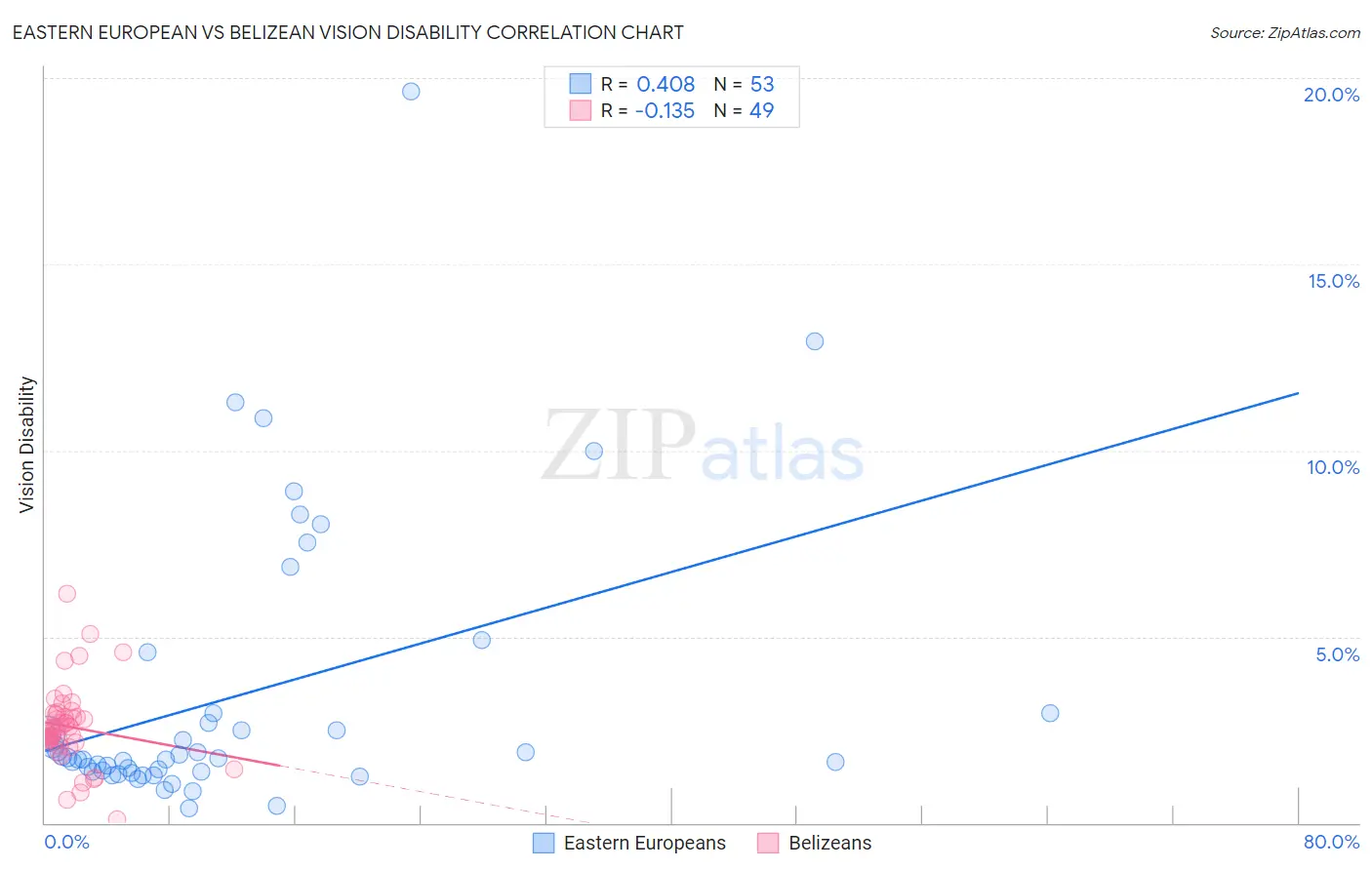Eastern European vs Belizean Vision Disability
COMPARE
Eastern European
Belizean
Vision Disability
Vision Disability Comparison
Eastern Europeans
Belizeans
2.0%
VISION DISABILITY
99.7/ 100
METRIC RATING
43rd/ 347
METRIC RANK
2.4%
VISION DISABILITY
0.2/ 100
METRIC RATING
260th/ 347
METRIC RANK
Eastern European vs Belizean Vision Disability Correlation Chart
The statistical analysis conducted on geographies consisting of 460,582,100 people shows a moderate positive correlation between the proportion of Eastern Europeans and percentage of population with vision disability in the United States with a correlation coefficient (R) of 0.408 and weighted average of 2.0%. Similarly, the statistical analysis conducted on geographies consisting of 144,166,801 people shows a poor negative correlation between the proportion of Belizeans and percentage of population with vision disability in the United States with a correlation coefficient (R) of -0.135 and weighted average of 2.4%, a difference of 20.9%.

Vision Disability Correlation Summary
| Measurement | Eastern European | Belizean |
| Minimum | 0.38% | 0.11% |
| Maximum | 19.6% | 6.1% |
| Range | 19.2% | 6.0% |
| Mean | 3.4% | 2.6% |
| Median | 1.7% | 2.6% |
| Interquartile 25% (IQ1) | 1.4% | 2.2% |
| Interquartile 75% (IQ3) | 3.0% | 2.9% |
| Interquartile Range (IQR) | 1.6% | 0.76% |
| Standard Deviation (Sample) | 3.8% | 1.1% |
| Standard Deviation (Population) | 3.8% | 1.1% |
Similar Demographics by Vision Disability
Demographics Similar to Eastern Europeans by Vision Disability
In terms of vision disability, the demographic groups most similar to Eastern Europeans are Immigrants from Indonesia (2.0%, a difference of 0.020%), Ethiopian (2.0%, a difference of 0.050%), Immigrants from Ethiopia (2.0%, a difference of 0.060%), Immigrants from Sweden (2.0%, a difference of 0.090%), and Immigrants from Bulgaria (2.0%, a difference of 0.11%).
| Demographics | Rating | Rank | Vision Disability |
| Cambodians | 99.8 /100 | #36 | Exceptional 2.0% |
| Bhutanese | 99.8 /100 | #37 | Exceptional 2.0% |
| Immigrants | Kuwait | 99.8 /100 | #38 | Exceptional 2.0% |
| Zimbabweans | 99.7 /100 | #39 | Exceptional 2.0% |
| Immigrants | Ireland | 99.7 /100 | #40 | Exceptional 2.0% |
| Cypriots | 99.7 /100 | #41 | Exceptional 2.0% |
| Immigrants | Ethiopia | 99.7 /100 | #42 | Exceptional 2.0% |
| Eastern Europeans | 99.7 /100 | #43 | Exceptional 2.0% |
| Immigrants | Indonesia | 99.7 /100 | #44 | Exceptional 2.0% |
| Ethiopians | 99.7 /100 | #45 | Exceptional 2.0% |
| Immigrants | Sweden | 99.7 /100 | #46 | Exceptional 2.0% |
| Immigrants | Bulgaria | 99.7 /100 | #47 | Exceptional 2.0% |
| Israelis | 99.6 /100 | #48 | Exceptional 2.0% |
| Latvians | 99.5 /100 | #49 | Exceptional 2.0% |
| Afghans | 99.5 /100 | #50 | Exceptional 2.0% |
Demographics Similar to Belizeans by Vision Disability
In terms of vision disability, the demographic groups most similar to Belizeans are White/Caucasian (2.4%, a difference of 0.17%), British West Indian (2.4%, a difference of 0.18%), West Indian (2.4%, a difference of 0.21%), Fijian (2.4%, a difference of 0.21%), and Jamaican (2.4%, a difference of 0.24%).
| Demographics | Rating | Rank | Vision Disability |
| Japanese | 0.3 /100 | #253 | Tragic 2.4% |
| Haitians | 0.3 /100 | #254 | Tragic 2.4% |
| Immigrants | Guatemala | 0.3 /100 | #255 | Tragic 2.4% |
| Immigrants | Haiti | 0.2 /100 | #256 | Tragic 2.4% |
| West Indians | 0.2 /100 | #257 | Tragic 2.4% |
| British West Indians | 0.2 /100 | #258 | Tragic 2.4% |
| Whites/Caucasians | 0.2 /100 | #259 | Tragic 2.4% |
| Belizeans | 0.2 /100 | #260 | Tragic 2.4% |
| Fijians | 0.1 /100 | #261 | Tragic 2.4% |
| Jamaicans | 0.1 /100 | #262 | Tragic 2.4% |
| Immigrants | Belize | 0.1 /100 | #263 | Tragic 2.4% |
| Immigrants | Liberia | 0.1 /100 | #264 | Tragic 2.4% |
| Immigrants | Jamaica | 0.1 /100 | #265 | Tragic 2.4% |
| Mexican American Indians | 0.1 /100 | #266 | Tragic 2.4% |
| Ute | 0.1 /100 | #267 | Tragic 2.4% |